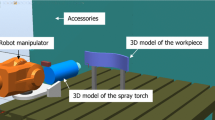Abstract
Automatic trajectory generation for spray painting is highly desirable for today’s automotive manufacturing. Generating paint gun trajectories for free-form surfaces to satisfy paint thickness requirements is still highly challenging due to the complex geometry of free-form surfaces. In this paper, a CAD-guided paint gun trajectory generation system for free-form surfaces has been developed. The system utilizes the CAD information of a free-form surface and a paint gun model to automatically generate a paint gun trajectory to satisfy the paint thickness requirements. Complex surfaces are divided into patches to satisfy the constraints. A trajectory integration algorithm is developed to integrate the trajectories of the patches. The paint thickness deviation from the required paint thickness is optimized by modifying the paint gun velocity. A paint thickness verification method is also developed to verify the generated trajectories. The results of simulations have shown that the trajectory generation system achieves satisfactory performance. This trajectory generation system can also be applied to generate trajectories for many other CAD-guided robot trajectory planning applications in surface manufacturing.
Similar content being viewed by others
References
Suh SH, Woo IK, Noh SK (1991) Development of an automatic trajectory planning system(atps) for spray painting robots. In: IEEE International Conference on Robotics and Automation, Sacramento, California, pp 1948–1955, April
Asakawa N, Takeuchi Y (1997) Teachingless spray-painting of sculptured surface by an industrial robot. In: IEEE International Conference on Robotics and Automation, Albuquerque, New Mexico, pp 1875–1879, April
Sheng W, Xi N, Song M, Chen Y, MacNeille P (2000) Automated cad-guided robot path planning for spray painting of compound surfaces. In: IEEE/RSJ International Conference On Intelligent Robots And Systems, Takamutsa, Japan, pp 1918–1923, October
Choset H (2000) Coverage of known spaces: the boustrophedon cellupdar decomposition. Auton Robots 9:247–253
Penin LF, Balaguer C, Pastor JM, Rodriguez FJ, Barrientos A, Aracil R (1998) Robotized spraying of prefabricated panels. IEEE Robot Autom Mag 5(3):18–29
Antonio JK, Ramabhadran R, Ling TL (1997) A framework for optimal trajectory planning for automated spray coating. Int J Robot Autom 12(4):124–134
Tecnomatix (1999) ROBCAD/Paint training. Tecnomatix, Michigan, USA
Chen H, Sheng W, Xi N, Song M, Chen Y (2002) Automated robot trajectory planning for spray painting of free-form surfaces in automotive manufacturing. IEEE Int Conf Robot Autom 1:450–455
Suh S, Woo I, Noh S (1991) Automatic trajectory planning system (atps) for spray painting robots. J Manuf Syst 10(5):396–406
Antonio JK (1994) Optimal trajectory planning for spray coating. In: IEEE International Conference on Robotics and Automation, San Diego, California, pp 2570–2577, May
Chang TC, Wysk RA, Wang HP (1998) Computer-aided manufacturing, 2nd edn. Prentice Hall, New Jersey
Lai JY, Wang DJ (1994) A strategy for finish cutting path generation of compound surface. Comput Ind 25:189–209
Persoons W, Van Brussel H (1993) Cad-based robotic coating with highly curved surfaces. In: International Symposium on Intelligent Robotics (ISIR’93), vol. 14, pp 611–618
Hertling P, Hog L, Larsen R, Perram JW, Petersen HG (1996) Task curve planning for painting robots. i. process modeling and calibration. IEEE Trans Robot Autom 12(2):324–330, April
Fu KS, Gonzalez RC, Lee CSG (1987) Robotics: control, sensing, vision and intelligence. McGraw-Hill, New York, NY, USA
Rao SS (1983) Optimization: theory and application. Wiley, New York, USA
Gill PE, Murray W, Wright MH (1981) Practical optimization. Academic Press, New York, NY, USA
Author information
Authors and Affiliations
Corresponding author
Rights and permissions
About this article
Cite this article
Chen, H., Xi, N. Automated tool trajectory planning of industrial robots for painting composite surfaces. Int J Adv Manuf Technol 35, 680–696 (2008). https://doi.org/10.1007/s00170-006-0746-5
Received:
Accepted:
Published:
Issue Date:
DOI: https://doi.org/10.1007/s00170-006-0746-5




